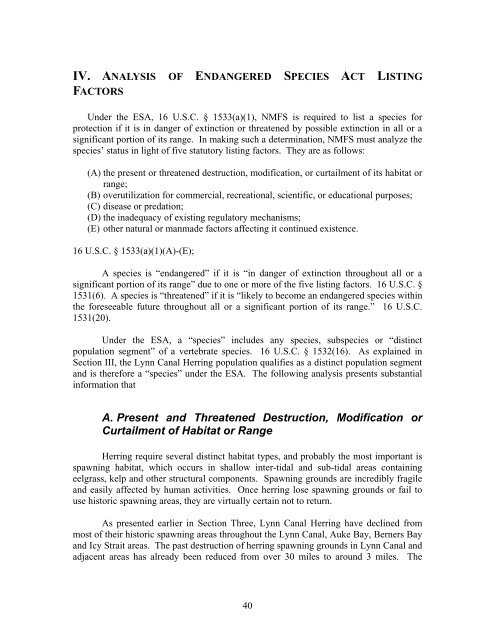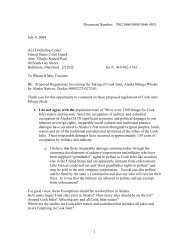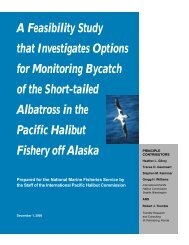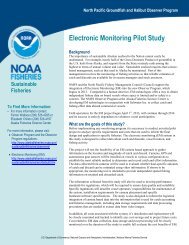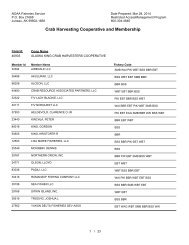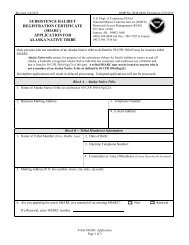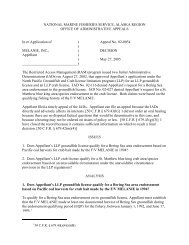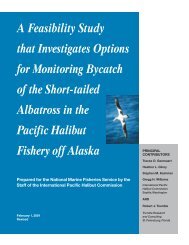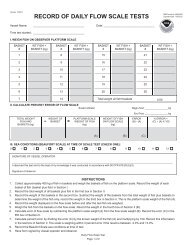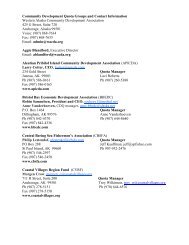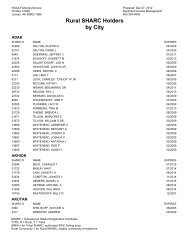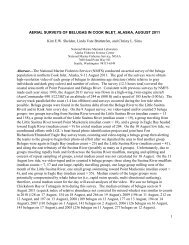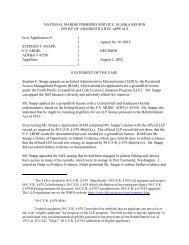Petition to List Lynn Canal Pacific Herring under the Endangered ...
Petition to List Lynn Canal Pacific Herring under the Endangered ...
Petition to List Lynn Canal Pacific Herring under the Endangered ...
Create successful ePaper yourself
Turn your PDF publications into a flip-book with our unique Google optimized e-Paper software.
IV. ANALYSIS OF ENDANGERED SPECIES ACT LISTING<br />
FACTORS<br />
Under <strong>the</strong> ESA, 16 U.S.C. § 1533(a)(1), NMFS is required <strong>to</strong> list a species for<br />
protection if it is in danger of extinction or threatened by possible extinction in all or a<br />
significant portion of its range. In making such a determination, NMFS must analyze <strong>the</strong><br />
species’ status in light of five statu<strong>to</strong>ry listing fac<strong>to</strong>rs. They are as follows:<br />
(A) <strong>the</strong> present or threatened destruction, modification, or curtailment of its habitat or<br />
range;<br />
(B) overutilization for commercial, recreational, scientific, or educational purposes;<br />
(C) disease or predation;<br />
(D) <strong>the</strong> inadequacy of existing regula<strong>to</strong>ry mechanisms;<br />
(E) o<strong>the</strong>r natural or manmade fac<strong>to</strong>rs affecting it continued existence.<br />
16 U.S.C. § 1533(a)(1)(A)-(E);<br />
A species is “endangered” if it is “in danger of extinction throughout all or a<br />
significant portion of its range” due <strong>to</strong> one or more of <strong>the</strong> five listing fac<strong>to</strong>rs. 16 U.S.C. §<br />
1531(6). A species is “threatened” if it is “likely <strong>to</strong> become an endangered species within<br />
<strong>the</strong> foreseeable future throughout all or a significant portion of its range.” 16 U.S.C.<br />
1531(20).<br />
Under <strong>the</strong> ESA, a “species” includes any species, subspecies or “distinct<br />
population segment” of a vertebrate species. 16 U.S.C. § 1532(16). As explained in<br />
Section III, <strong>the</strong> <strong>Lynn</strong> <strong>Canal</strong> <strong>Herring</strong> population qualifies as a distinct population segment<br />
and is <strong>the</strong>refore a “species” <strong>under</strong> <strong>the</strong> ESA. The following analysis presents substantial<br />
information that<br />
A. Present and Threatened Destruction, Modification or<br />
Curtailment of Habitat or Range<br />
<strong>Herring</strong> require several distinct habitat types, and probably <strong>the</strong> most important is<br />
spawning habitat, which occurs in shallow inter-tidal and sub-tidal areas containing<br />
eelgrass, kelp and o<strong>the</strong>r structural components. Spawning grounds are incredibly fragile<br />
and easily affected by human activities. Once herring lose spawning grounds or fail <strong>to</strong><br />
use his<strong>to</strong>ric spawning areas, <strong>the</strong>y are virtually certain not <strong>to</strong> return.<br />
As presented earlier in Section Three, <strong>Lynn</strong> <strong>Canal</strong> <strong>Herring</strong> have declined from<br />
most of <strong>the</strong>ir his<strong>to</strong>ric spawning areas throughout <strong>the</strong> <strong>Lynn</strong> <strong>Canal</strong>, Auke Bay, Berners Bay<br />
and Icy Strait areas. The past destruction of herring spawning grounds in <strong>Lynn</strong> <strong>Canal</strong> and<br />
adjacent areas has already been reduced from over 30 miles <strong>to</strong> around 3 miles. The<br />
40


